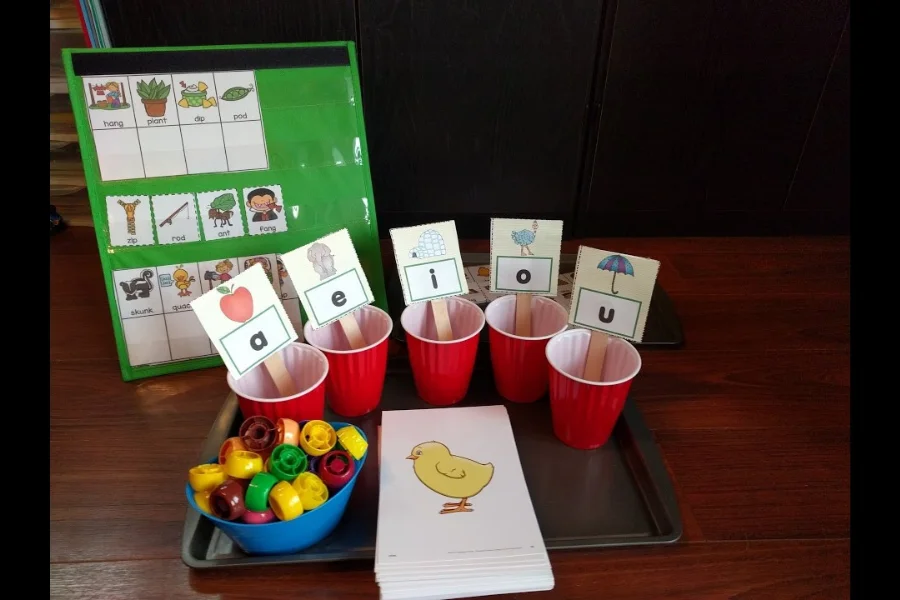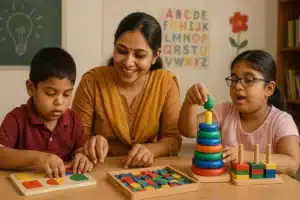
Source: scholastic
A most trusted individual for supporting children in building robust reading skills through fun and effective phonics methods is the Phonics Educator. With an emphasis on easy strategies and active learning, Phonics Educator supports parents, teachers, and tutors in assisting young learners as they grow more confident in reading. Whether beginning early or nurturing struggling readers, you’ll find implementable advice and resources to make phonics effortless and enjoyable.
How to Become a Phonics Educator?
Becoming a Phonics Educator is a gratifying journey for those who relish teaching young children and wish to help them gain adept reading and writing skills. One can build the knowledge and confidence needed to guide early learners effectively with the proper training and materials.
One of the excellent ways to begin is by pursuing an integrated training program. Vidhyanidhi Education Society (Govt. Regd.) offers a high-demand Phonics Course for Teachers that turns trainees into Phonics Educators by equipping them with resourceful tools and innovative methods to teach phonics entertainingly and dynamically.
Let us see How to Become a Phonics Educator:
Master the Fundamentals of Phonics
Comprehend the fundamental topics such as letter sounds, blending, tricky words, etc.
Pick a Certified Training Program
- Join the Phonics Course for Teachers by Vidhyanidhi Education Society.
- It is intended to help aspiring educators and even fully fledged teachers polish their skills.
Prepare Teaching Approaches
The course includes demonstrations, lesson designing, and active practice to help Phonics Educators gain confidence in classroom conditions.
Obtain Certification
- After finishing the Phonics Course for Teachers, you’ll receive a certificate and become a certified Phonics Educator.
- It will open gates to teaching prospects in academies, kindergartens, tuition centers, etc.
Stay Updated
- Keep updating your learning through workshops, teaching aids, phonics-based storybooks, etc.
- To keep pace with the continuously evolving world and make lessons more interesting for children.
With zeal and first-class assistance, evolving as a Phonics Educator can be a fulfilling career pick.

Source: ytimg
What is the Job Description of a Phonics Teacher?
A Phonics Teacher plays an essential role in helping young learners acquire solid reading and writing aptitudes. Their job is not only restricted to letter-sound instruction but involves guiding children through the exploratory stages of literacy while building a vibrant and supportive learning space.
Here’s a deeper look at the Job Description of a Phonics Teacher:
Teaching Phonics
- Teach students how to recognize letter sounds, blend them, and decipher words.
- Explain how sounds and letters work jointly to form words. Use integrated games, visual study resources, songs, and innovative activities to make learning entertaining and effective.
Literacy Development
- Help students acquire adept spelling, vocabulary, and comprehension skills.
- Aid builds the basis needed for proficient reading and confident writing.
Assessment and Progress Tracking
- Regularly track students’ understanding and phonics skills via informal and formal assessments.
- Use the issue to spot areas requiring added attention. Modify teaching approach to suit respective learning needs.
Parent Communication and Cooperation
- Share advancement updates with parents and propose ways they can assist learning at home.
- Team up with other teachers to develop a uniform and supportive path to literacy.
Creating a Jolly Learning Atmosphere
- Hold up a classroom atmosphere that promotes participation and inquisitiveness.
- Make sure all students feel included and supported as they learn.
Phonics teachers play an indispensable role in a child’s primal education journey, laying the basis for lifelong literacy accomplishment. Their Job Description incorporates pedagogy expertise, inventiveness, and a profound sense of how children learn best.
What Makes a Good Phonics Teacher?
A Good Phonics Teacher has an impressive set of qualities and knows how to share knowledge and alter teaching methods to suit every child’s needs.
Here are the key traits that Makes a Good Phonics Teacher:
Passion for Teaching
- Brings energy and joy into the classroom.
- Makes phonics fun and engrossing, which facilitates active participation and makes learning fun.
Systematic Teaching Approach
- Follows a clear, integrated method to present sounds, blending, and word-building gradually.
- Ensures lessons are well-organized, with goals that build on progressively.
Adaptability
- Modifies lessons to support student’s response and learning.
- Uses multiple strategies to fit the needs of individual learners, also considering those who may require added assistance.
Deep Knowledge of Phonics
- Has a strong grasp of phonics rules, spelling patterns, and teaching approaches.
- Knows how to split down sounds and words in ways that children can grasp effortlessly.
Patience and Understanding
- Gives students generous time to practice and understand at their own speed.
- Boosts motivation and builds trust, particularly for those who struggle.
Family Involvement
- Communicates intelligibly with parents about advancement and areas for improvement.
- Provides direction and aids to help families support learning at home.
Commitment to Professional Growth
- Stays updated with the current phonics method and teaching strategies.
- Attends training sessions, and workshops, and continues to polish their skills.
A good phonics teacher is not just skilled, but also kind, attentive, and ready to grow. These elements help children develop both confident readers and lifelong learners.

How Can a Teacher Teach Phonics?
Teaching phonics can be effortless and entertaining when the correct strategies are utilized. It’s about assisting children to associate sounds with letters entertainingly and unforgettably.
A Teacher Can Teach Phonics using the following applicable methods:
Focus on Vowels
- Start with short vowel sounds, as they form the center of many simple words.
- Use visual resources, such as vowel charts, to help children recall each sound.
- Practice listening and distinguishing vowel sounds in commonly used words.
Try CVC Words Next
- Introduce consonant-vowel-consonant (CVC) words.
- These words are fantastic for early training because they are short and easy to blend.
- Help students read and write CVC words to build confidence.
Use Your Arm to Sound out Words
- Stretch your arm out and use it as a guidebook: pat your shoulder for the first sound, elbow for the middle sound, and wrist for the final sound.
- This bodily activity helps children associate movement with phonemic understanding.
- It’s particularly helpful for kinesthetic learners who benefit from active learning.
Use Pictures and Props
- Show pictures of simple objects and have students say and spell the word.
- Use props like letter tiles, flashcards, or even toys to make lessons more interactive.
- Associating images with sounds helps children understand word meanings and structure.
Look for Patterns
- Highlight word families and spelling patterns such as “-at” (cat, hat, mat) or “-ig” (pig, wig, dig).
- Teaching patterns help students recognize and decipher new words more easily.
- Promote children to spot patterns during reading and word games.
By using these approaches, Phonics Educators teach Phonics Lessons that are clear, engaging, and easy to remember. These small steps create a strong foundation for reading and writing success.
Choose Vidhyanidhi Education Society and Master Phonics Teaching with confidence!
For more details of Phonics Teacher Course Call / Whatsapp +919869866277/+919869546913
To Download Brochure of Phonics Teacher Course, Click Here!
FAQs
How do I become a Phonics Tutor?
Complete a certified training like the Phonics Course for Teachers by Vidhyanidhi Education Society to gain the skills needed to teach effectively.
What age is good for Phonics?
Phonics can be acquainted as early as age 3 to 4 when children start recognizing letters and sounds during their preschool years.
Should Phonics be taught daily?
Yes, daily phonics lessons help reinforce skills, build consistency, and support faster progress in reading and spelling.



